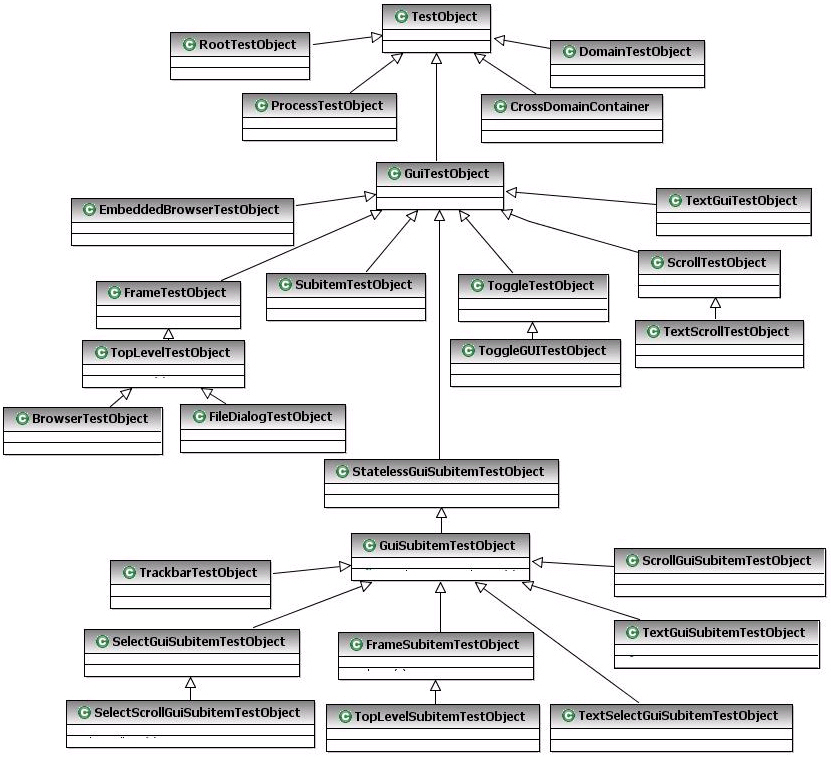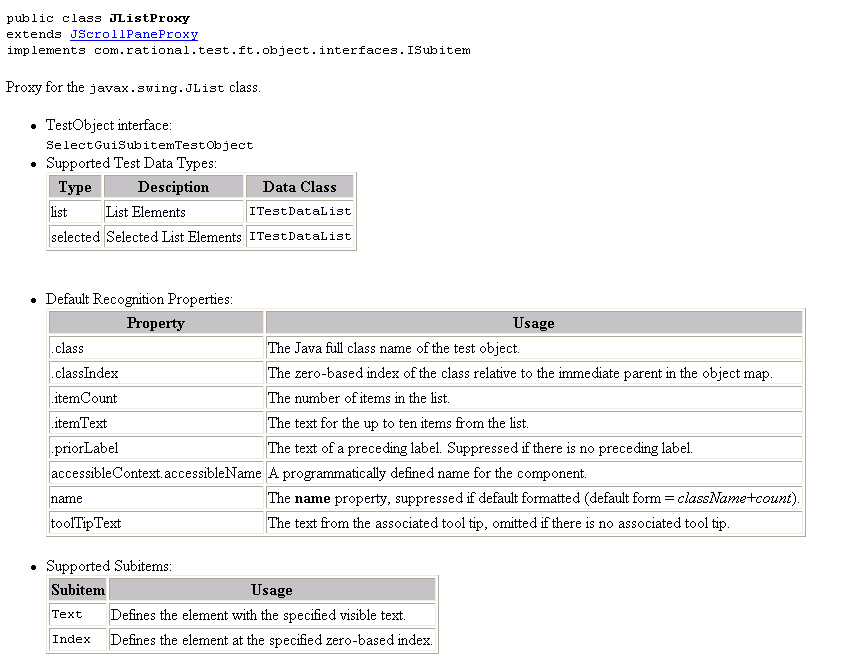
ç”±و¤هڈ¯è§پهQŒç»ه¤§ه¤ڑو•°çڑ„ه¯¹è±،都وک¯¾l§و‰؟ن؛?/span>GuiTestObjectه’?/span>GuiSubitemTestObjectم€‚ç±»ن¼?/span>Buttonه’?/span>CheckBoxکq™و ·çڑ„简هچ•ه¯¹è±،,è‡ھ然وک¯ç‘ôو‰؟ن؛ژGuiTestObjectهQŒè€ŒهƒڈListه’?/span>Tableکq™و ·çڑ„وœ‰ه†…部هگه¯¹è±،çڑ„ه¤چو‚ه¯¹è±،هQŒن¸€ه®ڑوک¯¾l§و‰؟ن؛?/span>GuiSubitemTestObjectم€‚و ¹وچ®è؟™ن¸€è§„ه¾‹هQŒه°±هڈ¯ن»¥هˆ†هˆ«ه»؛ç«‹ن½ و‰€éœ€è¦پçڑ„¾cضM؛†(ji¨£n)م€?/span>
è´ںè´£Buttonçڑ„ç±»ه¦‚ن¸‹هQ?font class="Apple-style-span" face="'Times New Roman'">
import java.awt.Point;
import org.slf4j.Logger;
import org.slf4j.LoggerFactory;
import com.rational.test.ft.object.interfaces.GuiTestObject;
import com.rational.test.ft.object.interfaces.TestObject;
public class WButton extends GuiTestObject {
public WButton(TestObject button) {
super(button);
}
public void click() {
super.click();
}
public void click(int x, int y) {
super.click(new Point(x, y));
}
public void doubleClick() {
super.doubleClick();
}
public boolean isEnabled() {
return super.isEnabled();
}
}
ه…¶ن»–½ژ€هچ•ه¯¹è±،ن¹ںهڈ¯ن»¥¾l§و‰؟ToggleGUITestObjectوˆ?/span>TextScrollTestObject½{‰ه…¶ن»–è،چç”ںن؛ژGuiTestObject¾c»ï¼Œکq™ن؛›¾cصd°پ装ن؛†(ji¨£n)ه¾ˆه¤ڑه®ç”¨çڑ„و–¹و³•هڈ¯ن»¥ç›´وژ¥ن‹ة用,ه…·ن½“请هڈ‚è€?/span>RFTو–‡و،£ن¸çڑ„APIم€?/span> è´ںè´£TabPaneçڑ„ç±»ه¦‚ن¸‹هQ?/p>
import java.util.Vector;
import org.slf4j.Logger;
import org.slf4j.LoggerFactory;
import com.rational.test.ft.object.interfaces.GuiSubitemTestObject;
import com.rational.test.ft.object.interfaces.TestObject;
import com.rational.test.ft.script.Index;
import com.rational.test.ft.script.Text;
import com.rational.test.ft.vp.ITestData;
import com.rational.test.ft.vp.ITestDataElementList;
import com.rational.test.ft.vp.ITestDataList;
public class WTabbedPane extends GuiSubitemTestObject {
static final Logger logger = LoggerFactory.getLogger("WTabbedPane.class");
public WTabbedPane(TestObject tabbedPane) {
super(tabbedPane);
}
public void clickTab(String tabName) {
this.click(new Text(tabName));
}
public void clickTab(int index) {
this.click(new Index(index));
}
public int getTabCount() {
logger.info("Get tab count");
ITestData data = (ITestData) super.getTestData("list");
ITestDataList list = (ITestDataList) data;
return list.getElementCount();
}
public int findTab(String text) {
logger.info("Find the index of tab {}", text);
Vector contents = this.getAllTabs();
for (int i = 0; i < contents.size(); i++) {
if (contents.get(i).toString().equals(text)) {
return i;
}
}
return -1;
}
public String getTabText(int index) {
logger.info("Get tab text with index {}", index);
Vector contents = this.getAllTabs();
if (index < 0 || index >= contents.size()) {
return null;
}
return (String) contents.get(index);
}
public Vector getAllTabs() {
logger.info("Get all tabs");
ITestDataList dataList = (ITestDataList) super.getTestData("list");
ITestDataElementList elementList = (ITestDataElementList) dataList
.getElements();
return elementList.getElements();
}
}
ç”׃¸ٹé¢çڑ„ن¾‹هگهڈ¯ن»¥çœ‹ه‡؛و¥ï¼Œه¯¹ه¯¹è±،çڑ„و“چن½œهڈ¯ن»¥هˆ†نط“(f¨´)ن¸¤ç±»هQڑن¸€¾cہLک¯و–½هٹ è،Œنط“(f¨´)هQŒن¸€¾cہLک¯è¯صdڈ–و•°وچ®م€‚ه¯¹و¤ï¼ŒRFTçڑ„API¾l™ه‡؛ن؛?ji¨£n)详¾l†çڑ„و–‡و،£هQŒن¾‹ه¦‚ه¯¹ن؛ژListه¯¹è±،هQŒو–‡و،£ه¦‚ن¸‹ï¼ڑ(x¨¬)

ç”±و¤هڈ¯çœ‹ه‡؛,ه¯¹ن؛ژListه¯¹è±،هQŒهڈ¯ن»¥é€ڑè؟‡.class, .classIndex, .itemCount, .itemText, .priorLabelهQŒaccessibleContext.accessibleNameهQŒnameه’ŒtoolTipTextکq™ن؛›ه±و€§è؟›è،Œè¯†هˆ«م€‚èژ·هڈ–Listه¯¹è±،هگژ,ه®ƒو”¯وŒپTextه’ŒIndexکq™ن¸¤¾cصdگه¯¹è±،هQŒهڈ¯é€ڑè؟‡ITestDataListوژ¥هڈ£èژ·ه¾—ه…¨éƒ¨هˆ—è،¨ه…ƒç´ ه’Œه·²é€‰هˆ—è،¨ه…ƒç´ م€‚ن¸ٹé¢getAllTabs()و–زژ(gu¨©)³•®±وک¯ç”¨و¥èژ·ه¾—و‰€وœ‰Tab选é،¹çڑ„,هڈ¯ن»¥ن½œنط“(f¨´)هڈ‚考م€?/span>
کqکوœ‰ن¸€ن؛›و›´ن¸؛ه¤چو‚çڑ„½ژ€هچ•ه¯¹è±،,ه¦‚ï¼ڑ(x¨¬)TextFieldه’ŒFrameهQŒن»¥هڈ?qi¨¢ng)ه¤چو‚ه¯¹è±،,ه¦‚ï¼?x¨¬)Tableه’ŒTreeم€‚ه¦‚وœن½ 能ه¤ںçگ†è§£ن¸ٹè؟°ه¤„çگ†ه¯¹è±،çڑ„و–¹و³•ï¼Œé‚£ن¹ˆه®Œه…¨هڈ¯ن»¥¾~–ه†™½W¦هگˆè‡ھه·±™ه¹ç›®éœ€è¦پçڑ„و–زژ(gu¨©)³•هQŒه¯¹کq™ن؛›ه¯¹è±،کq›è،Œهگ„ç§چهگ„و ·çڑ„و“چن½œم€?/span>
 public TestObject getObject(ArrayList<Property> v) {
public TestObject getObject(ArrayList<Property> v) {
 rootTO.waitForExistence(waitMaxTime, waitCheckInterval);
rootTO.waitForExistence(waitMaxTime, waitCheckInterval); TestObject returnObject = null;
TestObject returnObject = null; TestObject to[] = null;
TestObject to[] = null; double timeNow = System.currentTimeMillis() / 1000;
double timeNow = System.currentTimeMillis() / 1000; double endTime = timeNow + waitMaxTime;
double endTime = timeNow + waitMaxTime; v.add(new Property("showing", "true"));
v.add(new Property("showing", "true")); while (returnObject == null && timeNow < endTime) {
while (returnObject == null && timeNow < endTime) { to = rootTO.find(atDescendant((Property[]) v.toArray(new Property[0])));
to = rootTO.find(atDescendant((Property[]) v.toArray(new Property[0]))); if (to.length > 1) {
if (to.length > 1) { throw new AmbiguousRecognitionException("Find more than one object.");
throw new AmbiguousRecognitionException("Find more than one object."); }
} if (to.length == 1) {
if (to.length == 1) { returnObject = to[0];
returnObject = to[0]; } else
} else sleep(waitCheckInterval);
sleep(waitCheckInterval); timeNow = System.currentTimeMillis() / 1000;
timeNow = System.currentTimeMillis() / 1000; }
} return returnObject;
return returnObject; }
}
ن¸ٹé¢çڑ„و–¹و³•و ¹وچ®ن¼ ه…¥çڑ„هڈ‚و•°é›†هگˆه¯¹ه½“ه‰چçھ—هڈ£ن¸çڑ„و‰€وœ‰ه¯¹è±،è؟›è،Œوں¥و‰¾م€‚ه’Œن¹‹ه‰چçڑ„çھ—ن½“وں¥و‰¾ن¸€و ّP¼Œوœ€ه¥½وک¾½C؛çڑ„و·صdٹ showing=trueهڈ‚و•°هQŒه› ن¸؛هœ¨Swing½E‹ه؛ڈçڑ„è؟گè،Œè؟‡½E‹ن¸هQŒه†…هکن(sh¨´)¸ن¼?x¨¬)ه¯?/span>GUIه…ƒç´ کq›è،Œ¾~“هکهQŒهڈ¯èƒ½ن¸€ن¸ھç•Œé¢و¶ˆه¤×ƒ؛†(ji¨£n)هQŒن½†ه®ƒè؟کهœ¨ه†…هکن(sh¨´)¸هQŒç‰ه¾…ç€éڑڈهگژ被وک¾½C؛م€‚è؟™و ·ن¸€و¥ï¼Œ®±éœ€è¦پè؟™ن¸ھهڈ‚و•°è؟‡و»¤هˆ°و‰€وœ‰وœھ被وک¾½C؛çڑ„GUIه…ƒç´ م€‚هœ¨ه®é™…ن½؟用کq‡ç¨‹ن¸ï¼Œهڈ¯ن»¥ن½؟用ه¦‚ن¸‹çڑ„و–¹و³•è؟›è،Œè°ƒç”¨ï¼ڑ(x¨¬) هQˆè°ƒç”¨ه‰چن½؟用RFTçڑ„ه¯¹è±،وں¥çœ‹ه™¨¼‹®ه®ڑه¾…وں¥و‰‘ض¯¹è±،çڑ„ه”¯ن¸€ه±و€§ï¼‰(j¨ھ)
 protected WButton getButton(String name) {
protected WButton getButton(String name) { ArrayList<Property> v = new ArrayList<Property>();
ArrayList<Property> v = new ArrayList<Property>(); v.add(new Property(".class", "javax.swing.JButton"));
v.add(new Property(".class", "javax.swing.JButton")); v.add(new Property("accessibleContext.accessibleName", name));
v.add(new Property("accessibleContext.accessibleName", name)); TestObject to = og.getObject(v);
TestObject to = og.getObject(v); if (!Utility.exists(to))
if (!Utility.exists(to)) throw new ObjectNotFoundException();
throw new ObjectNotFoundException(); else
else return new WButton(to);
return new WButton(to); }
}ن¸ژçھ—هڈ£ه¤„çگ†ن¸€و ّP¼Œه¦‚وœوںگن؛›هڈ‚و•°éœ€è¦پن‹ة用و£هˆ™è،¨è¾‘ض¼ڈه¤„çگ†هQŒهڈ¯ن»¥ن‹ة用ن¸‹é¢çڑ„و–زژ(gu¨©)³•هQ?/span>
 protected WListBox getList(String label) {
protected WListBox getList(String label) { RegularExpression exp = new RegularExpression(".*JComboBox$|.*JList$", false);
RegularExpression exp = new RegularExpression(".*JComboBox$|.*JList$", false); ArrayList<Property> v = new ArrayList<Property>();
ArrayList<Property> v = new ArrayList<Property>(); v.add(new Property(".class", exp));
v.add(new Property(".class", exp)); v.add(new Property(".priorLabel", label));
v.add(new Property(".priorLabel", label)); TestObject to = og.getObject(v);
TestObject to = og.getObject(v); if (!Utility.exists(to))
if (!Utility.exists(to)) throw new ObjectNotFoundException();
throw new ObjectNotFoundException(); else
else return new WListBox(to);
return new WListBox(to); }
}هœ¨ه¯¹è±،وں¥و‰¾è؟‡½E‹ن¸هQŒهڈ¯èƒ½éœ€è¦پهگ„؟Uچن¸چهگŒçڑ„وں¥و‰¾é€»è¾‘م€‚ن¾‹ه¦‚,ه¦‚وœه¯¹è±،هڈ¯èƒ½هکهœ¨ن¹ںهڈ¯èƒ½ن¸چهکهœ¨هQŒهœ¨وں¥و‰¾çڑ„و—¶ه€™ه°±ن¸چ需è¦پç‰ه¾…هئˆهڈچه¤چوں¥و‰¾هQŒè؟™و—¶ه€™ï¼Œهڈ¯ن»¥ن½؟用ه¦‚ن¸‹çڑ„و–¹و³•ï¼ڑ(x¨¬)
 public TestObject getObjectWithoutWait(ArrayList<Property> v) {
public TestObject getObjectWithoutWait(ArrayList<Property> v) { rootTO.waitForExistence();
rootTO.waitForExistence(); TestObject returnObject = null;
TestObject returnObject = null; v.add(new Property("showing", "true"));
v.add(new Property("showing", "true")); TestObject to[] = rootTO.find(atDescendant((Property[]) v.toArray(new Property[0])));
TestObject to[] = rootTO.find(atDescendant((Property[]) v.toArray(new Property[0]))); if (to.length > 1) {
if (to.length > 1) { throw new AmbiguousRecognitionException(
throw new AmbiguousRecognitionException( Find more than one object.);
Find more than one object.); }
} if (to.length == 1) {
if (to.length == 1) { returnObject = to[0];
returnObject = to[0]; }
} return returnObject;
return returnObject; }
}
وœ‰و—¶ه€™ï¼Œç•Œé¢ن¸ٹوœ‰ه¤ڑن¸ھه…نhœ‰ç›¸هگŒه±و€§çڑ„ه¯¹è±،هQŒهڈھ能é€ڑè؟‡ن»–ن»¬çڑ„ç¼–هڈنh¥هŒ؛هˆ†ن»–ن»¬هQ›وœ‰و—¶ه€™éœ€è¦پن»¥وںگن¸ھ¼‹®ه®ڑه¯¹è±،ن¸؛و ¹و¥è؟›è،Œوں¥و‰¾ï¼›وœ‰و—¶ه€™éœ€è¦پوں¥و‰„،›´وژ¥هگه¯¹è±،而ن¸چوک¯و‰€وœ‰هگه¯¹è±،هQŒç‰½{‰م€‚هئˆن¸”,کq™ن؛›é€»è¾‘ن¹‹é—´ن¹ںهکهœ¨وژ’هˆ—组هگˆçڑ„وƒ…ه†µهQŒه®é™…ن‹ة用ن¸هڈ¯ن»¥و زژ(gu¨©)چ®è‡ھèيn需è¦پçپµ‹zصd¤„çگ†م€‚è؟™ن؛›و–¹و³•éƒ½وک¯ه¯¹ن¸ٹé¢هں؛وœ¬و–زژ(gu¨©)³•çڑ„و‰©ه±•ï¼Œه¤§ه®¶هڈ¯ن»¥®è¯•è‡ھه·±و¥ه®çژ°م€?/span>
 private double waitCheckInterval = ((Double) getOption(IOptionName.WAIT_FOR_EXISTENCE_DELAY_BETWEEN_RETRIES))
private double waitCheckInterval = ((Double) getOption(IOptionName.WAIT_FOR_EXISTENCE_DELAY_BETWEEN_RETRIES))  .doubleValue();
.doubleValue();  private double waitMaxTime = ((Double) getOption(IOptionName.MAXIMUM_WAIT_FOR_EXISTENCE))
private double waitMaxTime = ((Double) getOption(IOptionName.MAXIMUM_WAIT_FOR_EXISTENCE))  .doubleValue();
.doubleValue();  private TestObject rootTO = null;
private TestObject rootTO = null;  public boolean getRootWithCaption(String captionExpr) {
public boolean getRootWithCaption(String captionExpr) {  double timeNow = System.currentTimeMillis() / 1000;
double timeNow = System.currentTimeMillis() / 1000;  double endTime = timeNow + waitMaxTime;
double endTime = timeNow + waitMaxTime;  rootTO = null;
rootTO = null;  while (rootTO == null && timeNow < endTime) {
while (rootTO == null && timeNow < endTime) {  RootTestObject root = RootTestObject.getRootTestObject();
RootTestObject root = RootTestObject.getRootTestObject();  TestObject[] ftWinObjects = null;
TestObject[] ftWinObjects = null;  RegularExpression exp = new RegularExpression(captionExpr, false);
RegularExpression exp = new RegularExpression(captionExpr, false);  ArrayList<Property> v = new ArrayList<Property>();
ArrayList<Property> v = new ArrayList<Property>();  v.add(new Property(".captionText", exp));
v.add(new Property(".captionText", exp));  v.add(new Property(".domain", "Java"));
v.add(new Property(".domain", "Java"));  v.add(new Property("showing", "true"));
v.add(new Property("showing", "true"));  ftWinObjects = root.find(atChild((Property[]) v.toArray(new Property[0])));
ftWinObjects = root.find(atChild((Property[]) v.toArray(new Property[0])));  if (ftWinObjects != null) {
if (ftWinObjects != null) {  if (ftWinObjects.length > 1) {
if (ftWinObjects.length > 1) {  throw new AmbiguousRecognitionException("Find more windows with capture: " + captionExpr);
throw new AmbiguousRecognitionException("Find more windows with capture: " + captionExpr);  }
}  if (ftWinObjects.length == 1) {
if (ftWinObjects.length == 1) {  rootTO = ftWinObjects[0];
rootTO = ftWinObjects[0];  return true;
return true;  }
}  } else {
} else {  sleep(waitCheckInterval);
sleep(waitCheckInterval);  timeNow = System.currentTimeMillis() / 1000;
timeNow = System.currentTimeMillis() / 1000;  }
}  }
}  return false;
return false;  }
} 
ن¸ٹé¢çڑ„و–¹و³•é¦–ه…ˆهڈ–ه¾—ه¯¹è±،وں¥و‰„،ڑ„é—´éڑ”و—‰™—´م€پوœ€ه¤§ç‰ه¾…و—¶é—ك_(d¨¢)¼Œٍq¶ه£°وکژن؛†(ji¨£n)½I؛çڑ„½H—ن½“ه¯¹è±،م€‚وژ¥ن¸‹و¥کq›ه…¥و–زژ(gu¨©)³•هQŒو ¹وچ®وں¥و‰„،»“وœه’Œوœ€ه¤§ç‰ه¾…و—¶é—´و¥ه¾ھçژ¯وں¥و‰¾½H—ن½“م€‚ه…ˆèژ·ه¾—و زژ(gu¨©)µ‹è¯•ه¯¹è±،,然هگژوں¥و‰¾ه…¶ç›´وژ¥هگه¯¹è±،هQŒوں¥و‰¾و،ن»¶نط“(f¨´)هQڑçھ—ن½“و ‡é¢ک符هگˆو£هˆ™è،¨è¾‘ض¼ڈcaptionExprçڑ„ه®ڑن¹‰ï¼Œه±ن؛ژJavaهںں,ٍq¶ن¸”ه½“ه‰چن¸؛وک¾½C؛çٹ¶و€پم€‚وœ€هگژه¤„çگ†وں¥و‰„،»“وœï¼Œه¦‚وœ¾l“وœه¤§ن؛ژ1ن¸ھ,هˆ™وٹ›ه‡؛ه¼‚ه¸¸ï¼›ه¦‚وœ¾l“وœ½{‰ن؛ژ1هQŒهˆ™کq”ه›trueهQ›ه¦‚وœç»“وœنط“(f¨´)½I؛,هˆ™ç‰ه¾…هئˆé‡چو–°è®،ç®—و—‰™—´هQŒهئˆ¾l§ç®‹(hu¨¤)ه¾ھçژ¯وں¥و‰¾هQ›ه¦‚وœوœ€هگژن»چوœھç©؛ٍq‰™€€ه‡؛هَ@çژ¯ï¼Œهˆ™è؟”ه›?/span>falseم€?/span>
وœ‰çڑ„و—¶ه€™ï¼Œ½H—هڈ£çڑ„ه‡؛çژ°هئˆن¸چوک¯ن¸€ه®ڑçڑ„هQŒن¾‹ه¦‚ه¾ˆه¤ڑه¼¹ه‡؛çھ—هڈ£م€‚è؟™و—¶ه€™ï¼Œه¯¹è±،وں¥و‰¾ٍq¶ن¸چ需è¦پهَ@çژ¯ç‰ه¾…,相ه؛”çڑ„و–¹و³•ه؛”ن¸؛ï¼ڑ(x¨¬)
 public boolean getRootWithCaptionWithoutWait(String captionExpr) {
public boolean getRootWithCaptionWithoutWait(String captionExpr) {  rootTO = null;
rootTO = null;  sleep(waitCheckInterval);
sleep(waitCheckInterval);  RootTestObject root = RootTestObject.getRootTestObject();
RootTestObject root = RootTestObject.getRootTestObject();  TestObject[] ftWinObjects = null;
TestObject[] ftWinObjects = null;  RegularExpression exp = new RegularExpression(captionExpr + "$", false);
RegularExpression exp = new RegularExpression(captionExpr + "$", false);  ArrayList<Property> v = new ArrayList<Property>();
ArrayList<Property> v = new ArrayList<Property>();  v.add(new Property(".captionText", exp));
v.add(new Property(".captionText", exp));  v.add(new Property(".domain", "Java"));
v.add(new Property(".domain", "Java"));  v.add(new Property("showing", "true"));
v.add(new Property("showing", "true"));  ftWinObjects = root.find(atChild((Property[]) v.toArray(new Property[0])));
ftWinObjects = root.find(atChild((Property[]) v.toArray(new Property[0])));  if (ftWinObjects != null) {
if (ftWinObjects != null) {  if (ftWinObjects.length > 1) {
if (ftWinObjects.length > 1) {  throw new AmbiguousRecognitionException("Find more windows with capture: " + captionExpr);
throw new AmbiguousRecognitionException("Find more windows with capture: " + captionExpr);  }
}  if (ftWinObjects.length == 1) {
if (ftWinObjects.length == 1) {  rootTO = ftWinObjects[0];
rootTO = ftWinObjects[0];  return true;
return true;  }
}  }
}  return false;
return false;  }
} 
کq™و ·ن¸€و¥ï¼Œ®±هڈ¯ن»¥ç”¨¾lںن¸€çڑ„و–¹و³•و¥کq›è،Œ½H—ن½“çڑ„وں¥و‰¾م€‚ه…·ن½“ن»£ç په¦‚ن¸‹ï¼ڑ(x¨¬)
 protected boolean ExistWin(String winName, boolean wait) {
protected boolean ExistWin(String winName, boolean wait) {  release();
release();  if (wait)
if (wait)  return og.getRootWithCaption(winName);
return og.getRootWithCaption(winName);  else
else  return og.getRootWithCaptionWithoutWait(winName);
return og.getRootWithCaptionWithoutWait(winName);  }
} 
 public boolean isDialog(String caption, boolean wait) {
public boolean isDialog(String caption, boolean wait) {  return super.ExistWin(caption, wait);
return super.ExistWin(caption, wait);  }
} ه‰چن¸€ن¸ھو–¹و³•هˆ©ç”¨ن¼ ه…¥çڑ„½H—ن½“و ‡é¢کو£هˆ™è،¨è¾¾ه¼ڈ,ه’Œçھ—ن½“وں¥و‰ùN€»è¾‘هQŒè؟›è،Œçھ—ن½“وں¥و‰¾م€‚هگژن¸€ن¸ھو–¹و³•ه¯¹ه…¶è؟›è،Œè°ƒç”¨ï¼Œکq”ه›وک¯هگ¦وں¥و‰¾وˆگهٹںçڑ„结وœم€‚ن؛‹ه®ن¸ٹهQŒè؟™ن¸¤ن¸ھو–زژ(gu¨©)³•ه®Œه…¨هڈ¯ن»¥ه†™وˆگن¸€ن¸ھ,ن½†وک¯هœ¨è®¾è®،و،†و¶و—¶هQŒه؛”考虑هˆ°è‡ھهٹ¨هŒ–و“چن½œçڑ„هگ„ن¸ھçژ¯èٹ‚,ه؛”وٹٹو¯ڈن¸€ن¸ھçژ¯èٹ‚独立ه¼€و¥ï¼Œو‰چ能ه…نhœ‰وœ€ه¤§çڑ„çپ‰|´»و€§م€‚و ¹وچ®وˆ‘çڑ„ç»ڈéھŒï¼Œه¯¹ه¯¹è±،çڑ„وں¥و‰¾ه’Œوں¥و‰‘ضگژçڑ„و“چن½œه؛”独立وˆگن¸¤ن¸ھن¸چهگŒç±»و¥ه®Œوˆگ,ه…¶ن¸ه¯¹ه¯¹è±،çڑ„وں¥و‰¾ه؛”نط“(f¨´)ن¸€ن¸?/span>RFTçڑ?/span>super classم€‚ه…¶ه®ن¹ں®±وک¯¾l§و‰؟ن؛?/span>RationalTestScript¾cبڑ„وٹ½è±،¾c»ï¼Œه¯¹ه¯¹è±،çڑ„و“چن½œه؛”نط“(f¨´)ن¸€ن¸?/span>ScriptهQŒè؟™ن¸?/span>Scriptçڑ?/span>super classه؛”نط“(f¨´)è‡ھه·±ن¹‹ه‰چه®ڑن¹‰çڑ„ه¯¹è±،وں¥و‰„،±»هQŒè€Œن¸چوک¯é»ک认çڑ„RationalTestScriptم€‚è؟™ن¸€éƒ¨هˆ†هگژé¢کqکن(sh¨´)¼ڑ(x¨¬)讲هˆ°م€?/span>
ه½“需è¦په…³é—هڈ¯èƒ½ه‡؛çژ°çڑ„错误½H—هڈ£و—س¼Œهڈ¯ن»¥کq™و ·ن½؟用هQ?/span>
 if (aDialog.isDialog(".*Error", false)) {
if (aDialog.isDialog(".*Error", false)) {  aDialog.close();
aDialog.close();  }
} ه½“需è¦پو“چن½œن¸€ه®ڑه‡؛çژ°çڑ„½H—هڈ£و—س¼Œهڈ¯ن»¥کq™و ·ن½؟用هQ?/span>
 if (aDialog.isDialog("Warning", true)) {
if (aDialog.isDialog("Warning", true)) {  aDialog.clickButton("Yes");
aDialog.clickButton("Yes");  }
} è‡دx(ch¨®ng)¤هQŒو‰€وœ‰é’ˆه¯¹çھ—ن½“çڑ„ه¤„çگ†é€»è¾‘®±هں؛وœ¬ه®Œو•´ن؛†(ji¨£n)م€‚ه½“ç„?d¨°ng)¼Œهڈ¯èƒ½وœ‰ن؛›è¢«وµ‹½E‹ه؛ڈهڈ¯ن»¥هگŒو—¶و‰“ه¼€ه¤ڑن¸ھه®ن¾‹هQŒè؟™®±éœ€è¦پو”¯وŒپهگŒو—¶èژ·هڈ–هئˆو“چن½œه¤ڑن¸ھه…نhœ‰ç›¸هگŒو ‡é¢کçڑ„çھ—ن½“م€‚è؟™و ïL(f¨¥ng)ڑ„é—®é¢که¤§ه®¶هڈ¯ن»¥ن¸€هگŒوژ¢è®¨ه¦‚ن½•ه¤„çگ†م€?/span>
وک¯ن¸€ن¸ھهچپهˆ†ن¼ک؟U€çڑ„è‡ھهٹ¨هŒ–‹¹‹è¯•ه·¥ه…·م€‚ه°¤ه…¶وک¯ç›®ه‰چçڑ?/span>7.0.1.2وڈگن¾›ن؛?ji¨£n)ه¾ˆه¤ڑهں؛¼‹€è®¾و–½هQŒن¾‹ه¦‚ï¼ڑ(x¨¬)ه¯¹è±،çڑ„وک ®„م€پهٹ¨ن½œçڑ„ه½•هˆ¶/وˆ?/span>TxTçڑ„ن‹ة用者هœ¨ن½؟用کq‡ç¨‹ن¸ه؟½ç•¥ن؛†(ji¨£n)ه¯¹è؟™ن؛›هں؛¼‹€è®¾و–½èƒŒهگژه†…ه®¹çڑ„ن؛†(ji¨£n)解,ن»¥è‡³ن؛ژه‡؛çژîC؛†(ji¨£n)é—®é¢کوںو‰‹و— ç–م€‚ه…¶ه®ï¼ŒRFTوڑ´éœ²¾l™ن‹ة用者,هڈھè¦پ用ه¥½کq™ن؛›APIوœ‰ن¸€ŒD‰|—¶é—´çڑ„ن؛؛,ه؛”该çں¥éپ“IBMه؛“,وک¯ن¸“门针ه¯?/span>RFTٍqك_(d¨¢)¼‰(j¨ھ)هQŒه¦‚وœن½ ن½؟用وœ€و–°çڑ„RFT7.0都هڈکهŒ–ن؛†(ji¨£n)هQŒè؟™ن¸ھه؛“وœ‰ن¸چ®‘部هˆ†éƒ½ن¸چ能用ن؛†(ji¨£n)م€?/span>
وک¯ن¸€ن¸ھه¤ڑن¹ˆçپµ‹zبڑ„ه·¥ه…·هQŒن¹ںو£ه› ن¸ّ™؟™ن¸€ç‚¹ï¼Œه¾ˆه¤ڑن؛؛都ن¸چوکژ白ه¦‚ن½•èƒ½ه¤ںو£¼‹®çڑ„ن½؟用RFTن½؟用çڑ„وœ€ن½?j¨©ng)_®è·µه°±وک¯ه¼€هڈ‘ه±ن؛ژè‡ھه·قqڑ„‹¹‹è¯•و،†و¶م€‚هڈھوœ‰è؟™و نh‰چ能هڈ‘وŒ?/span>RFTç•Œé¢çڑ„é،¹ç›®ï¼Œن»‹ç»چن¸€ن¸‹ه¦‚ن½•ه¼€هڈ‘è‡ھه·قqڑ„‹¹‹è¯•و،†و¶م€‚(SwingهQ‰م€?/span>
وڈگن¾›çڑ„هں؛¼‹€è®¾و–½هQŒçپµ‹zہL€§ه¾ˆه·®م€‚ه…·ن½“ه†…ه®ڑwڑڈهگژه°†é€گن¸€ن»‹ç»چم€?/span>


